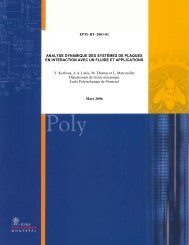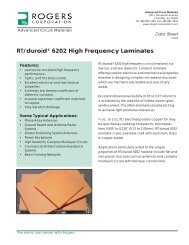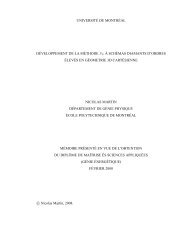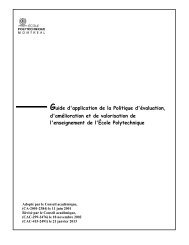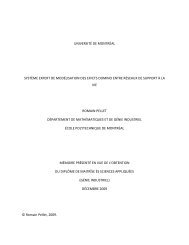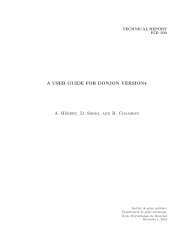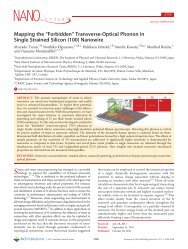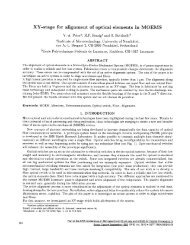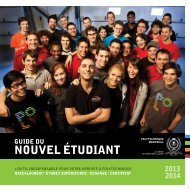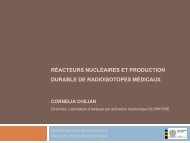Online Body Tracking by a PTZ Camera in IP Surveillance System
Online Body Tracking by a PTZ Camera in IP Surveillance System
Online Body Tracking by a PTZ Camera in IP Surveillance System
You also want an ePaper? Increase the reach of your titles
YUMPU automatically turns print PDFs into web optimized ePapers that Google loves.
are recognized from motion images. Then, detected irises are<br />
used as feature for face detection. The face needs to be large<br />
enough to detect the irises. In the method of Bernard<strong>in</strong> et<br />
al. [10], the upper body histogram <strong>in</strong>formation, KLT feature<br />
tracker, and active camera calibration are comb<strong>in</strong>ed to track the<br />
person. It is used for 3D localization. In the algorithm of Li et<br />
al. [11] each observer should be learned from different ranges<br />
of samples, with various subsets of features. Their method<br />
needs a learn<strong>in</strong>g step that is based on model complexity<br />
and <strong>in</strong>creases computation time. The method has limitations<br />
<strong>in</strong> dist<strong>in</strong>guish<strong>in</strong>g between different targets, and has model<br />
overupdat<strong>in</strong>g problems. Kang et al. [12] used a geometric<br />
transform-based mosaic<strong>in</strong>g method for person track<strong>in</strong>g <strong>by</strong> a<br />
<strong>PTZ</strong> camera. For each consecutive frame, it f<strong>in</strong>ds the good<br />
features for the correspondence and then tries to shift the<br />
moved image and update the changed background. They are<br />
us<strong>in</strong>g a high cost background model<strong>in</strong>g us<strong>in</strong>g a calibration<br />
scheme, which is not suitable for track<strong>in</strong>g <strong>by</strong> <strong>in</strong>ternet-based<br />
<strong>PTZ</strong> cameras.<br />
III. SYSTEM ARCHITECTURE<br />
The servo controll<strong>in</strong>g and track<strong>in</strong>g system is modeled <strong>by</strong> a<br />
closed-loop control which has a negative feedback as shown <strong>in</strong><br />
Fig. 1. Servo system consists of three ma<strong>in</strong> blocks which are<br />
image capture, visual process<strong>in</strong>g, and camera control. <strong>Track<strong>in</strong>g</strong><br />
is affected <strong>by</strong> two delays which are the delay τ 1 from image<br />
capture and the delay τ 2 <strong>in</strong> the feedback loop from execut<strong>in</strong>g<br />
camera motion commands. The delay for visual process<strong>in</strong>g is<br />
much smaller than the two other delays, thus it is neglected.<br />
The <strong>in</strong>put of the system is the current pan and tilt angles<br />
of the camera. The output will be the determ<strong>in</strong>ed pan and tilt<br />
angles <strong>by</strong> the fuzzy classifier. The delays imply that the current<br />
position of the target cannot be used for center<strong>in</strong>g the camera.<br />
To compensate for motion of the target dur<strong>in</strong>g the delays, a<br />
position predictor block is added. The algorithms which are<br />
used for the servo system control are expla<strong>in</strong>ed <strong>in</strong> Section IV.<br />
IV. METHODOLOGY<br />
Our method is based on compar<strong>in</strong>g elliptic samples with<br />
the target model and evaluat<strong>in</strong>g their likelihood to estimate<br />
the location of the target. We have made the follow<strong>in</strong>g<br />
assumptions: 1) persons walk at a normal pace or fast, but<br />
do not run, and 2) the FOV is wide (approximately 48 ◦ ) and<br />
3) scenes are not crowded (max 2-3 persons).<br />
A. Visual process<strong>in</strong>g<br />
1) Target model<strong>in</strong>g: A target is represented <strong>by</strong> an elliptical<br />
image region. It is modeled <strong>by</strong> two features: 1) quantized HSV<br />
color histogram with 162 b<strong>in</strong>s (i.e. 18×3×3), and 2) the mean<br />
of R, G and B color components of RGB color space of all<br />
the pixels <strong>in</strong>side of the elliptical region. Initialization is done<br />
manually <strong>by</strong> select<strong>in</strong>g the top part of the body (head and torso)<br />
of the person. We fit an ellipse <strong>in</strong>side the bound<strong>in</strong>g box of the<br />
selected region (Fig. 2 (a) and (e)) because it approximates<br />
adequately the shape of the head and torso. Then the <strong>in</strong>itial<br />
target M is modeled <strong>by</strong> the two discussed features.<br />
2) Target candidate detection: For track<strong>in</strong>g, we sample<br />
with ellipses the image around regions of <strong>in</strong>terest and model<br />
them. There are two regions of <strong>in</strong>terest: 1) areas with motion,<br />
2) the center of the image.<br />
• Motion-based samples: The first type of samples is detected<br />
<strong>by</strong> estimat<strong>in</strong>g the motion of the target from two<br />
consecutive images I 1 and I 2 , us<strong>in</strong>g pyramidal Lucas<br />
Kanade optical flow [13]. In optical flow [14], strong<br />
corners <strong>in</strong> the image which have big eigenvalues are<br />
detected for comparison. To solve pixel correspondence<br />
problem for a given pixel <strong>in</strong> I 1 , we look for near<strong>by</strong> pixels<br />
of the same color <strong>in</strong> I 2 . We use 4 pyramid levels with 10<br />
iterations. The threshold is 0.3.<br />
As found experimentally, the detected motion vector<br />
results are noisy. In addition, the camera motion vectors<br />
have effect on object motion vectors. Thus, to remove this<br />
effect, camera motion vectors are extracted. To calculate<br />
the camera motion vectors, a radial histogram of motion<br />
vectors is calculated. In a radial histogram, each b<strong>in</strong> is<br />
based on the quantized length (r) and angle (θ) of the<br />
motion vector. Our radial histogram, h(r, θ) has 36180<br />
b<strong>in</strong>s. r has 200 values and is varied based on the image<br />
size between 1 and image diameter. θ has 180 values and<br />
is varied between 0 ◦ and 360 ◦ . The r and θ of the b<strong>in</strong><br />
that has the maximum number of vectors is assigned to be<br />
the camera motion vector length and angle. The detected<br />
motion vectors which have this length and angle are<br />
removed and then the camera motion vector is subtracted<br />
from the rest of the motion vectors.<br />
Motion-based samples are extracted around object motion<br />
vectors. Sample size is large or small. The largest samples<br />
are used for zoom<strong>in</strong>g or for object approach<strong>in</strong>g the<br />
camera. Their area is 1/3 of the image area. The small<br />
samples are used for targets far from the camera and close<br />
to the center <strong>in</strong> different positions. The sizes of these<br />
elliptic samples are obta<strong>in</strong>ed experimentally accord<strong>in</strong>g to<br />
the m<strong>in</strong>imum face size, which is <strong>in</strong> our algorithm 5x5<br />
pixels from frontal and lateral views. We consider F<br />
small samples located uniformly and one large sample<br />
for each motion vector group (typically F = 16).<br />
• Fixed samples: Accord<strong>in</strong>g to our goal, the object should<br />
be always near the image center. To have robust track<strong>in</strong>g<br />
even when there is no motion from the target, we consider<br />
G additional fixed samples <strong>in</strong> the image (typically G =<br />
10).<br />
The ellipses are then modeled as expla<strong>in</strong>ed previously.<br />
3) Sample likelihood us<strong>in</strong>g a fuzzy classifier: To localize<br />
the target, features of each sample S i are compared with the<br />
<strong>in</strong>itial model M, and a score (ScoreS i ), or sample likelihood<br />
is given to each S i us<strong>in</strong>g a fuzzy rule. The score is obta<strong>in</strong>ed<br />
<strong>by</strong> multiply<strong>in</strong>g four fuzzy membership functions which will<br />
be expla<strong>in</strong>ed <strong>in</strong> the follow<strong>in</strong>g.<br />
ScoreS i = µ EC .µ EP .µ EH .µ H . (1)<br />
The target is the sample with the highest score. We are us<strong>in</strong>g<br />
four membership functions, each with fuzzy outputs between


